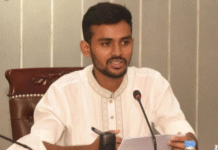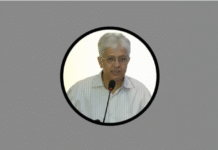Assam’s NRC data conundrum

After the Indian Supreme Court recently rejected the Indian central and Assamese governments’ plea for sample re-verification of names included in the National Register of Citizens (NRC), politics has begun playing out afresh over the issue. On August 1, the Bharatiya Janata Party government in Assam released, in the legislative assembly, data related to inclusion and exclusion of names in 33 districts of Assam in the draft final NRC, which was released in July, 2018, and called into question the fairness of the exercise of updating the NRC.
Making public the data, Assam’s Parliamentary Affairs Minister Chandra Mohan Patowary argued that there is a higher inclusion of names in districts associated with immigration and lower in other districts. It cited the statistics to make out a case for a review of the 20 percent of NRC names in Assamese districts bordering Bangladesh and ten percent in the remaining areas. The final draft NRC, published in July last year, contained the names of 2.89 crore out of the 3.29 crore applicants and kept out about 40 lakh people. In June this year, another one lakh people were excluded from the NRC as part of a check and verification exercise conducted by the NRC Coordinator.
The data tabled in the state legislature is all about demographic profile in different parts of Assam to show 12.15 percent of the applicants’ names were excluded from the final draft published in July last year. The figures of exclusion in the districts sharing border with Bangladesh are: 7.22 percent in South Salmara, 8.26 percent in Dhubri, and 7.67 percent in Karimganj. These three districts are Muslim-majority. However, the figure of exclusion is higher in dominant indigenous population districts: 14.31 percent in Karbi Anglong and 13.25 percent in Tinsukia in upper Assam. In Guwahati city, far from the border, nearly 18 percent of the names are not included in the NRC.
The Assam government’s plea for 20 percent re-verification of the inclusion rates in districts bordering Bangladesh is based on the assessment that these areas are bound to have a high percentage of illegal immigrants. But there is another interesting picture that emerges from the data: higher exclusion percentages have been recorded in Muslim-majority districts (not border districts) like Morigaon (52.56 percent Muslims as per the census of 2011), Barpeta (70.74 percent Muslims as per the 2011 census) and Nagaon (55.36 percent Muslims according to the same census). The rate of exclusion in Morigaon is 15.04 percent, in Barpeta 13.4 percent, and in Nagaon 14.12 percent, according to the data.
By questioning the fairness of the process of updating the NRC and attacking NRC Coordinator Prateek Hajela, the Assam government may have placed itself in a bind because the Supreme Court has rejected the plea for re-verification and given the go-ahead for publication of the final NRC on August 31 this year. During the debate on the NRC data, several legislators of the BJP criticised the updating process and brought allegations of bribery and other irregularities like family legacy document manipulation for inclusion of names in the document. The broad message sent out by the legislators’ speeches is that the NRC updating exercise is flawed.
Initiating the discussion, BJP lawmaker Debananda Hazarika said “a fair NRC will mean Magna Carta but if it is full of error, it will threaten the integrity and sovereignty of the country.” Another BJP lawmaker Shiladitya Dev contended that the NRC exercise has become a one-man exercise of Prateek Hajela and that it is going to be a “defective” list of Indian citizens. Topping it all, Patowary alleged that there had been a large-scale misuse of legacy data in districts bordering Bangladesh and therefore the percentage of non-inclusion of names in the NRC there is less. On the other hand, senior Congress leader and former Assam Chief Minister Tarun Gogoi alleged the current state government was not serious about completing the NRC.
What complicated things further is the sudden flurry of notices issued to thousands of people in Assam in the first week of August to appear for hearings in connection with the NRC within a shortened deadline, even though the Supreme Court had mandated in its April 10 order that at least 15 days’ notice in advance be given for this. There was no clarity as to how many such notices were sent across Assam. Many people who got these notices claimed they had earlier attended such hearings when claims to inclusion of names and objections to inclusions were being heard.
The history of human civilisation is often a history of migration. But in the case of Assam, academics have over the decades remained divided over what contributed to the growth of Muslim population in Assam. Nandita Saikia, Assistant Professor of Population Studies in Jawaharlal Nehru University in Delhi, in comments made to The Indian Express newspaper, was not inclined to attribute this growth to natural causes and explained this in terms of immigration.
Abdul Mannan, former Professor of Statistics in Gauhati University, discussed in his book “Infiltration: The Genesis of Assam Movement” the rise of the Muslim population in the state and concluded that this had been fuelled by natural factors rather than planned migration, because an overwhelming majority of the Muslims are poor and illiterate. While Saikia said the NRC data was not scientifically collected; Mannan, in remarks carried by The Indian Express, described the Assam government’s interpretation of the NRC data as “sheer propaganda not supported by statistics.”
The huge uncertainty looming over those who will be left out of the NRC will pose an enormous humanitarian problem. What will be the contours of the approach to solve the issue that has roiled Assam for decades? Should it be looked at from a purely legalistic point of view or from a polarising narrative? Any solution will have to take into account that any migration—legal or illegal—is mostly a story of the search for economically greener pastures. So, at some point, it boils down to an increased competition to secure scarce natural and economic resources.
Pallab Bhattacharya is a special correspondent for The Daily Star.









